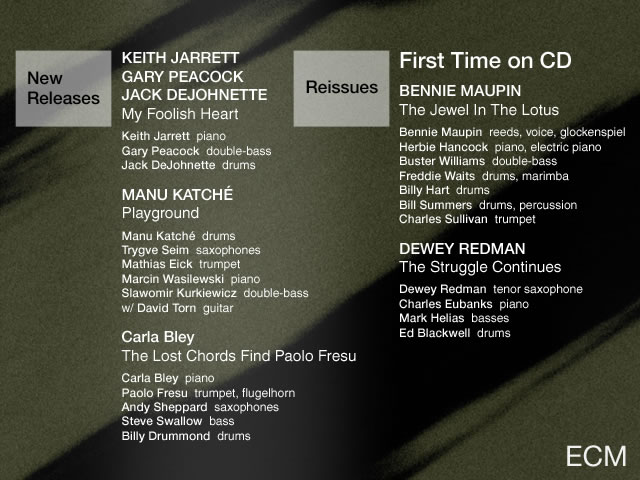Moment's Notice
Recent CDs Briefly Reviewed
(continued)
Bruce Eisenbeil Sextet
Inner Constellation
Nemu007
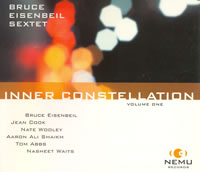 The core of this CD, the 47-minute title work, is described by Eisenbeil as through-composed. It’s performed by a sextet that consists of violinist Jean Cook, trumpeter Nate Wooley, alto saxophonist Aaron Ali Shaikh, bassist Tom Abbs and drummer Nasheet Waits. According to Eisenbeil’s media sheet, it grew out of a 2001 experience that had him, Cook, and Sheikh rehearsing in a 40-piece Cecil Taylor ensemble, and further, from his specific listening to the late ‘70s Taylor band with its trumpet, alto, violin front-line. In Eisenbeil’s re-formulation, his guitar occupies roughly the orchestral position of Taylor’s piano. There are further similarities to Taylor in the method of composition – the piece is rooted in a group of tonal relations that are elaborated and expanded in various ways throughout the piece, creating layers and harmonic fields. As has long been Taylor’s practice, the musicians learned their parts by ear. Every five minutes composed materials appear to act as springboard for a soloist, and in the music’s tumult it’s hard (an early unison glissando apart) to determine where and how composition and improvisation divide, and we may be learning to see them less as distinct activities. More and more they seem to exist as choices in some of the most advanced performance forms. Eisenbeil’s structure suggests that he is reaching back, too, to the proto-type of such pieces, Ornette Coleman’s Free Jazz.
The core of this CD, the 47-minute title work, is described by Eisenbeil as through-composed. It’s performed by a sextet that consists of violinist Jean Cook, trumpeter Nate Wooley, alto saxophonist Aaron Ali Shaikh, bassist Tom Abbs and drummer Nasheet Waits. According to Eisenbeil’s media sheet, it grew out of a 2001 experience that had him, Cook, and Sheikh rehearsing in a 40-piece Cecil Taylor ensemble, and further, from his specific listening to the late ‘70s Taylor band with its trumpet, alto, violin front-line. In Eisenbeil’s re-formulation, his guitar occupies roughly the orchestral position of Taylor’s piano. There are further similarities to Taylor in the method of composition – the piece is rooted in a group of tonal relations that are elaborated and expanded in various ways throughout the piece, creating layers and harmonic fields. As has long been Taylor’s practice, the musicians learned their parts by ear. Every five minutes composed materials appear to act as springboard for a soloist, and in the music’s tumult it’s hard (an early unison glissando apart) to determine where and how composition and improvisation divide, and we may be learning to see them less as distinct activities. More and more they seem to exist as choices in some of the most advanced performance forms. Eisenbeil’s structure suggests that he is reaching back, too, to the proto-type of such pieces, Ornette Coleman’s Free Jazz.
Eisenbeil achieves an indecipherable coherence similar to Taylor’s, and he does it largely on his own terms. The band is everything he might ask for – each member possesses both adaptability and identity--and his own performance sets a new standard for his work. His guitar work has an aggressive brilliance about it, a special tautness that tears through octaves and sets off rhythmic firestorms. While no one is liable to compare it Taylor’s unique piano craft, there are moments here where violin, bass and guitar seem to fuse into a single extraordinary instrument, and the collective music often creates that Taylor illusion of instruments as extensions of the central organizing instrument.
Complementing “Inner Constellation” are three short improvisations by the trio of Eisenbeil, Abbs and Waits. They are utterly different in sound, intimate rather than orchestral and radically disconnected. In the beautifully odd “Receding Storm,” Eisenbeil sounds like a conventionally warm-toned jazz guitarist whose instrument has been radically detuned.
-Stuart Broomer
Peter Evans Quartet
The Peter Evans Quartet
Firehouse 12 FH12-04-01-004
Mostly Other People Do The Killing
Shamokin!!!
Hot Cup 063
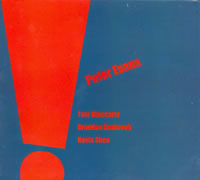 In 2006, Peter Evans’ solo trumpet album More Is More (psi) was voted among the Top 50 Records of the Year by polled critics of The Wire; on these two releases he adds to his impressive catalog of extended techniques a proficiency in modern jazz (post-Eldridge) phrasing and an ironic perspective on source material. The self-stated goal of his new, eponymous quartet is to recontextualize the familiar components of mainstream jazz — fragments of tunes and favorite licks, chord structures and modulations, bebop-and-beyond rhythms — with “many layers of melody and noise piled on top.” In so doing, the quartet attack their abstract originals with a relentless fervor — guitarist Brandon Seabrook injects blasts of electricity into “Tag” and spiky, heavily reverbed effects into “Frank Sinatra,” just as Evans’ alternately jolting and gusty trumpet bruise the mood. There are moments — often due to the coherent rhythmic push of bassist Tom Blancarte and drummer Kevin Shea — when the energetic distortions have the feel of an edgy, updated “hot” jazz. But there’s also a dryness to the aggressively disjunct arrangements, and a sense of desperation to the noise, that occasionally confuse the issue.
In 2006, Peter Evans’ solo trumpet album More Is More (psi) was voted among the Top 50 Records of the Year by polled critics of The Wire; on these two releases he adds to his impressive catalog of extended techniques a proficiency in modern jazz (post-Eldridge) phrasing and an ironic perspective on source material. The self-stated goal of his new, eponymous quartet is to recontextualize the familiar components of mainstream jazz — fragments of tunes and favorite licks, chord structures and modulations, bebop-and-beyond rhythms — with “many layers of melody and noise piled on top.” In so doing, the quartet attack their abstract originals with a relentless fervor — guitarist Brandon Seabrook injects blasts of electricity into “Tag” and spiky, heavily reverbed effects into “Frank Sinatra,” just as Evans’ alternately jolting and gusty trumpet bruise the mood. There are moments — often due to the coherent rhythmic push of bassist Tom Blancarte and drummer Kevin Shea — when the energetic distortions have the feel of an edgy, updated “hot” jazz. But there’s also a dryness to the aggressively disjunct arrangements, and a sense of desperation to the noise, that occasionally confuse the issue.
There’s a broader range of styles, as well as an obvious layer of satire, throughout Shamokin!!!, from the boogaloo, accelerated ballad, and free-bop tunes to the back cover Blue Note design and tongue-in-cheek liner notes from one “Leonardo Featherweight” (whose inflated prose and crazed name-dropping beat the prospective reviewer to the punch). The influences on display are easily accessed — Mingus, Horace Silver, Anthony Braxton, Johnny Hodges and Duke Ellington among them — but this foursome, led by bassist Moppa Elliott, employ exaggerated, often contrary gestures to stretch the recognizable structures out of shape without completely shredding them. Evans and alto saxophonist Jon Irabagon find consistently supple solo solutions — the trumpeter reaffirms his chops of steel (or steel-wool on “Night in Tunisia”), while Irabagon, who likes to salt his solos with quotes, variously alludes to Cannonball Adderley, Roscoe Mitchell, and pibroch without sounding incongruous. The humor is slathered a bit thick in spots, but it’s balanced by solid musicianship and a keen eye for detail. And what’s with that name?
-Art Lange
Vinny Golia + Aurora Josephson + Henry Kaiser + Mike Keneally + Joe Morris + Damon Smith + Weasel Walter
Healing Force: The Songs of Albert Ayler
Cuneiform Records/Rune 255
His Name Is Alive
Sweet Earth Flower: A Tribute to Marion Brown
High Two HT014
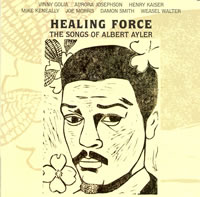 These two CDs, appearing almost simultaneously, share striking similarities in content and methodology, creating memorable work out of “missing” chapters in the current jazz history.
These two CDs, appearing almost simultaneously, share striking similarities in content and methodology, creating memorable work out of “missing” chapters in the current jazz history.
Healing Force is a Henry Kaiser project; like his Yo, Miles! with Leo Smith an act of reclamation, this one investigates late-period Albert Ayler, the variously ignored and excoriated music of New Grass and Music Is the Healing Force in the Universe, when Ayler combined his expressionist form of free jazz with rock rhythms and the voice and lyrics of Mary Maria Parks. According to Kaiser, “While there are some moments of brilliance and surprise among them, they seem to me not to entirely realize the prospects that Ayler felt for those recording projects...We selected a representative set of tunes for this material and essentially let it play itself through us.” How this treatment might “solve” late Ayler will depend how you read the material. For many listeners Ayler’s pop-oriented material seemed a betrayal, the shabby sell-out of a great voice of liberation. It might be read, however, as Ayler`s seeking a larger audience for a populist spiritual message. There`s much to be said for Kaiser`s view and the realization of it in this project. The band has been assembled from various styles—free jazz, free improvisation, and experimental rock, and the interesting thing is how much more listenable this CD is than the originals, so radically compromised by the incompatibility of the players and a probable lack of rehearsal. Nearly forty years later, it may be that musicians now speak the musical language that Ayler was formulating in the crisis of free jazz and psychedelia. Here the guitar players (Kaiser and Joe Morris), and the singers (Aurora Josephson and Mike Keneally—also on piano and guitar) and the rhythm players (bassist Damon Smith and drummer Weasel Walter) can all improvise along with Vinny Golia, who excels at the Herculean task of playing reeds: roaring baritone on “New New Grass;” a Pharoah Sanders-like roar on “Music Is the Healing Force…;” wonderfully contorted soprano on “New Generation;” and, strangest of all, weird ’50s cool jazz flute (not in Ayler’s vocabulary) on “Heart Love.” The group finds a collective language that seems to do more with these songs than Ayler’s own records could. Among the approaches (some available in the original period) are an adaptation of the drone groove adopted by Sanders (going so far as to include his “Japan” as music that belongs here). The guitar playing comes from Hendrix, and sometimes the rhythms come from Beefheart and the Magic Band. “New Generation” gets a passively abstracted, out-of-tune punk vocal from Josephson that seems fitting for the banal lyrics from forty years ago (“It’s a new generation that really knows what time it is”), all nicely framed by broken Beefheart-like rhythms from Keneally and Walter. I still wish Mary Parks` lyrics were in a language I don`t understand.
I don`t know much about Warn Defever and his band His Name Is Alive, but on the basis of Sweet Earth Flower, he ought to be running the jazz program at Lincoln Centre: he makes honest, emotionally direct music that should appeal to many. Marion Brown may be best known for his appearance on Coltrane’s Ascension, but his own recordings from the late ‘60s and early ‘70s, now largely unavailable, are notable for a distinctly personal lyricism and a profound immersion in folkloric sources and narrative, e.g. Afternoon of a Georgia Faun (ECM) and Geechee Recollections (Impulse). It’s that emphasis on lyricism and roots that Defever expands on here, joined by eight other musicians from the Ann Arbor area, most of them members of the Afro-funk band Nomo. The music doesn’t depend on flashy solos, though Defever, tenor saxophonist Elliot Bergman and trumpeter Justin Walter (from Nomo) and altoist Michael Herbst (from Antibalas) all sound fine; rather, it`s the strong melodic statement, waves of rhythm and collective jams. The music is rich in the feeling of return--memory, echo, reflection, resonance, feedback. When Defever plays acoustic piano it’s with the sustain pedal down, when he plays electric guitar, it’s with feedback. There’s a glorious brassy resonance to Walter’s theme statement on “Sweet Earth Flying” and there’s some of the most effective use I’ve heard of electric piano, almost like a mbiri in its sonic and cultural resonance. The CD opens and closes with versions of “Sweet Earth Flying,” studio and live, and there are also two versions of “Geechee Recollections;” further, “Bismillahi `Rrahmani `Rrahim” is a fine outing in an Indian hypnotic vein. Given the stark melodies and declamatory presentations, there’s a feeling almost of prayer about the music. It has a loop like quality, and I found I could hear it happily all day.
-Stuart Broomer
Paul Hartsaw/ + Kristian Aspelin/ + Damon Smith/ + Jerome Bryerton
Ausfegen: Dedicated to Joseph Beuys
Balance Point Acoustic BPA 012
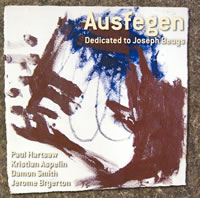 This quartet combines musicians from the San Francisco Bay area (guitarist Aspelin and bassist Smith) with two from Chicago, (saxophonist Hartsaw and percussionist Bryerton). The music is free improvisation and the interaction is subtle in the extreme – there’s an almost constant activity using extended techniques – string harmonics, cymbal scraping, and what sounds like portions of a saxophone being played independently. What matters though is the level of conversational detail, a touchstone whether the group is playing as a quartet, trio or duo. Hartsaw’s approach to the saxophone is speech-like in the extreme, at times he sounds like someone providing a detailed description, clarifying phrases, adding details, citing ambiguities. The long final track – “Pamphlet Printed on Plastic Bag” – achieves a stunning hive of continuous sound. The Beuys connection comes in quite literally. Nearing the end of the session, Smith felt they needed another approach. He noticed a shop broom in the studio and suggested Aspelin use it to play his guitar while he bowed two basses on the floor. The title comes from Beuys’s 1972 performance piece “Ausfegen,” in which he swept Karl-Marx-Platz in Berlin. The music here is worthy of the dedication, as rich in inference as the Beuys piece by which the CD’s range of suggestion is further extended and enriched. Like Keith Rowe’s one-time use of Stasi (East German secret police) recordings, this music, its methods, structures and materials are connected with the world-at-large, interacting with it in myriad ways.
This quartet combines musicians from the San Francisco Bay area (guitarist Aspelin and bassist Smith) with two from Chicago, (saxophonist Hartsaw and percussionist Bryerton). The music is free improvisation and the interaction is subtle in the extreme – there’s an almost constant activity using extended techniques – string harmonics, cymbal scraping, and what sounds like portions of a saxophone being played independently. What matters though is the level of conversational detail, a touchstone whether the group is playing as a quartet, trio or duo. Hartsaw’s approach to the saxophone is speech-like in the extreme, at times he sounds like someone providing a detailed description, clarifying phrases, adding details, citing ambiguities. The long final track – “Pamphlet Printed on Plastic Bag” – achieves a stunning hive of continuous sound. The Beuys connection comes in quite literally. Nearing the end of the session, Smith felt they needed another approach. He noticed a shop broom in the studio and suggested Aspelin use it to play his guitar while he bowed two basses on the floor. The title comes from Beuys’s 1972 performance piece “Ausfegen,” in which he swept Karl-Marx-Platz in Berlin. The music here is worthy of the dedication, as rich in inference as the Beuys piece by which the CD’s range of suggestion is further extended and enriched. Like Keith Rowe’s one-time use of Stasi (East German secret police) recordings, this music, its methods, structures and materials are connected with the world-at-large, interacting with it in myriad ways.
-Stuart Broomer
Mari Kimura
Polytopia
Bridge 9236
 Given her various activities, which range from teaching computer music at Julliard to improvising with, among others, Robert Dick and Elliott Sharp, the idea of a Polytopia, multiple idylls, suits Mari Kimura well. The collection’s sub title – “music for violin and electronics” – is applied somewhat liberally, since only an unaltered recording of Conlon Nancarrow’s player piano is used for a reading of his warp-speed “Toccata.” There’s also the hair-splitting over whether the computer-generated sounds in works by Kimura and Tania León are actually electronic in the old-school application of the term. However, these are moot points in the face of Kimura’s sterling virtuosity, her refined approach to integrating computers and even robots into her own compositional vocabulary, and her acumen in creating a program with such disparate pieces as Frances White’s text-driven “The Old Rose Reader” and Milica Paranosic’s Balkan music-inspired “ComeCryWithMe.” Although the technology is constantly in the foreground of the music, Kimura’s violin remains its primary focal point. On pieces like Jean-Claude Risset’s “Variants,” Kimura’s pyrotechnics outshine the streaming digital variations her playing sets off. On Robert Rowe’s “Submarine,” Kimura gives an astonishing demonstration of her unique subharmonics technique, which enables her to play notes below the open G string without retuning the instrument. Still, Kimura’s efforts to collaborate with signal processing, interactive computer programs et al are not to be understated on this often thrilling album.
Given her various activities, which range from teaching computer music at Julliard to improvising with, among others, Robert Dick and Elliott Sharp, the idea of a Polytopia, multiple idylls, suits Mari Kimura well. The collection’s sub title – “music for violin and electronics” – is applied somewhat liberally, since only an unaltered recording of Conlon Nancarrow’s player piano is used for a reading of his warp-speed “Toccata.” There’s also the hair-splitting over whether the computer-generated sounds in works by Kimura and Tania León are actually electronic in the old-school application of the term. However, these are moot points in the face of Kimura’s sterling virtuosity, her refined approach to integrating computers and even robots into her own compositional vocabulary, and her acumen in creating a program with such disparate pieces as Frances White’s text-driven “The Old Rose Reader” and Milica Paranosic’s Balkan music-inspired “ComeCryWithMe.” Although the technology is constantly in the foreground of the music, Kimura’s violin remains its primary focal point. On pieces like Jean-Claude Risset’s “Variants,” Kimura’s pyrotechnics outshine the streaming digital variations her playing sets off. On Robert Rowe’s “Submarine,” Kimura gives an astonishing demonstration of her unique subharmonics technique, which enables her to play notes below the open G string without retuning the instrument. Still, Kimura’s efforts to collaborate with signal processing, interactive computer programs et al are not to be understated on this often thrilling album.
-Bill Shoemaker
